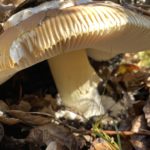Tucked into less than a square mile of land next to a freeway, the Peninsula’s Edgewood Park is a showcase for stunning wildflower diversity, all the result of our region’s unique geology.
-150x150.jpg)
Sign up for our free weekly newsletter and understand everything better!
-150x150.jpg)
Tucked into less than a square mile of land next to a freeway, the Peninsula’s Edgewood Park is a showcase for stunning wildflower diversity, all the result of our region’s unique geology.
-150x150.jpg)
All around the Bay Area in spring, herons and egrets begin their annual transformation from mostly solitary top predators to birds gathered in crowded breeding colonies. Local photographer Philip Greene has spent years following the whole subtle and spectacular process by which these large birds break down their resistance to social communion: the changing color of bills and legs, the growth of flowing nuptial plumage, and the complex gestures and dances that make up the fine art of getting to know one another.

David Amme, author of “Grassland Heritage” in Bay Nature’s April-June 2004 issue, called purple needlegrass “the undisputed candidate for official state grass.” Now that may soon become literally as well as figuratively true: State Sen. Michael Machado, D-Linden, is sponsoring … Read more

Rush Ranch Open Space features the largest intact brackish tidal marsh in the San Francisco Estuary. That’s why it has been designated, along with China Camp State Park, as California’s newest and largest National Estuarine Research Reserve (NERR). The NERR … Read more

Another area along the North Bay shoreline has been in the news lately: the 1,679 acres of the Sonoma Baylands located at the intersection of Lakeville Highway and Highway 37. On November 10, 2003, the Federated Indians of Graton Rancheria … Read more

A good rain sends all manner of mushrooms pushing their way up from underground. Here are some of the places around the Bay Area where you can admire the beauty and diversity of these charismatic fungi.

I wonder if the rest of you will be as surprised as I was to learn that the area around Fifth and Mission Streets in San Francisco used to be dominated by sand hills, some at least 40 feet high. … Read more

In technical terms, mushrooms are the charismatic sexual reproductive structures of fungal individuals whose main body (fine, cobweb-like filaments called hyphae) is well hidden in the soil or amongst leaves and rotting wood. The primary role of the mushroom is … Read more
-150x150.jpg)
The rounded hills by the Bay are the first thing that catch your eye at Coyote Hills Regional Park. But the brackish and freshwater marshes behind the hills have a charm of their own. Remnant of a once-extensive mix of tidal and freshwater wetlands that sustained a thriving Ohlone community for several thousand years, the marsh is now home to marsh wrens, muskrats, and one of the East Bay’s few remaining patches of tules.
-150x150.jpg)
A million years ago, in a climate much like ours today, the land around an ancestral bay teemed with large animals: mammoths and saber-tooth cats; bears, horses, and peccaries. By 300 years ago, the mammoths were gone, but grizzlies, elk, condor, and pronghorn were abundant.European settlers wiped out many of those animals, but programs to reintroduce some of them are now under way. Which raises the question: What should a healthy, native megafauna look like now?